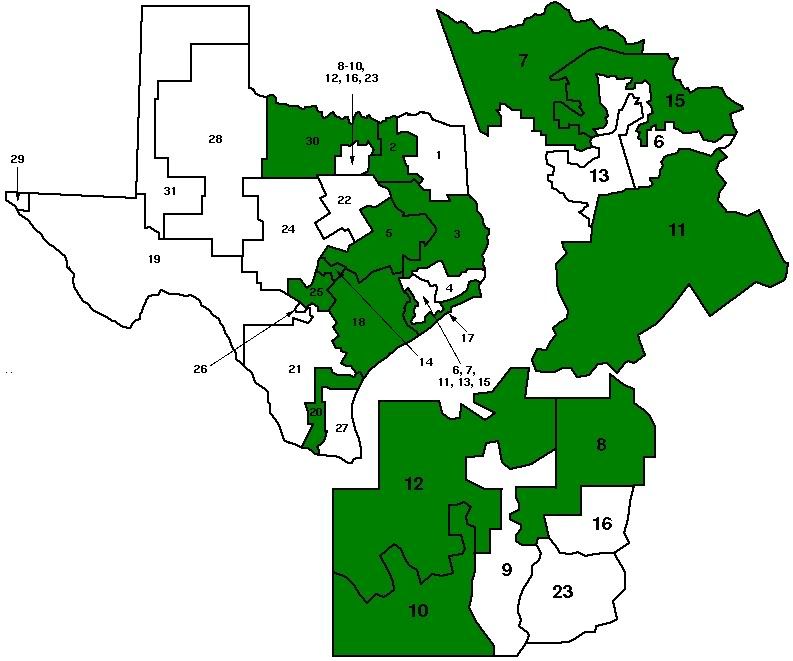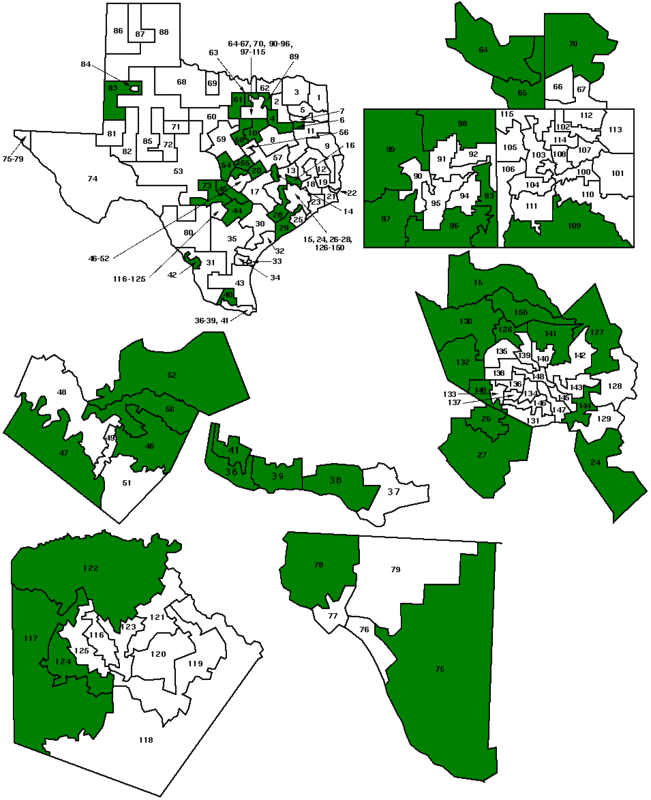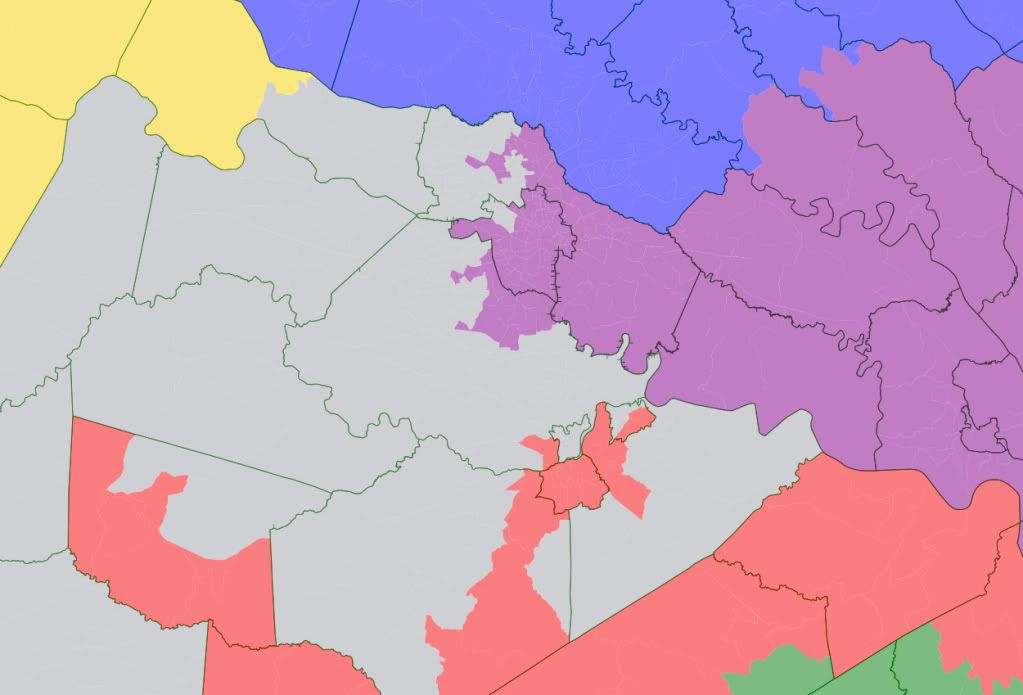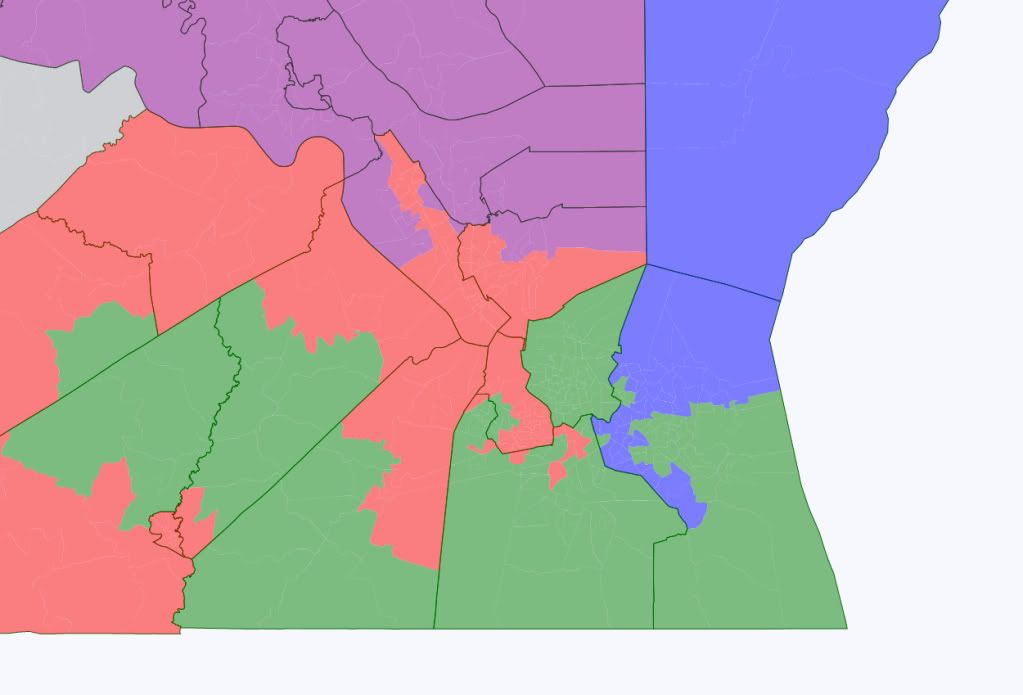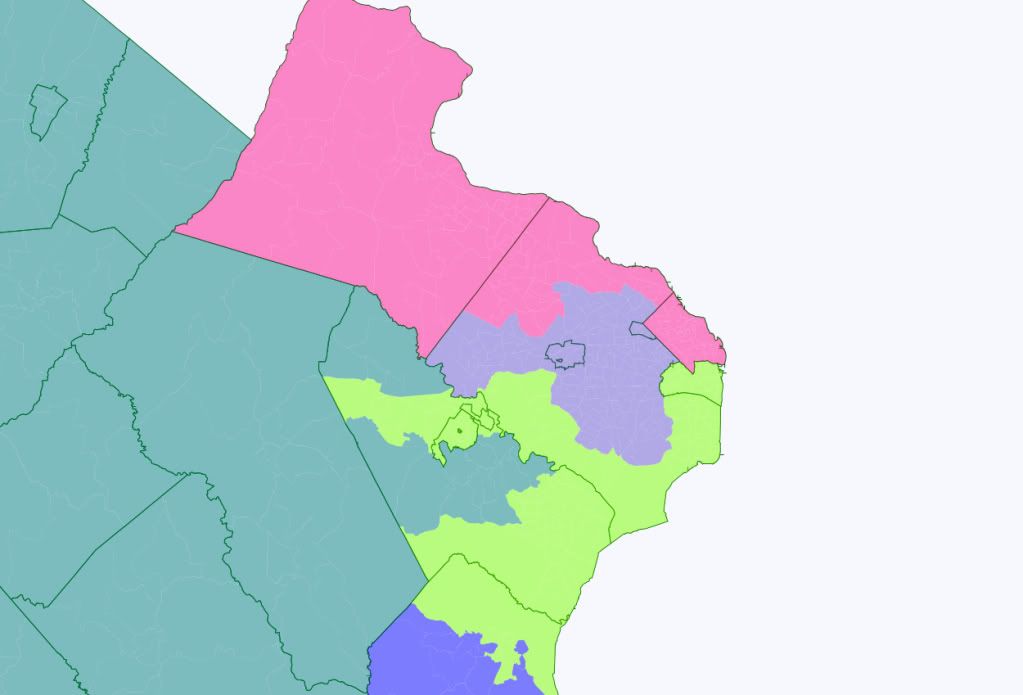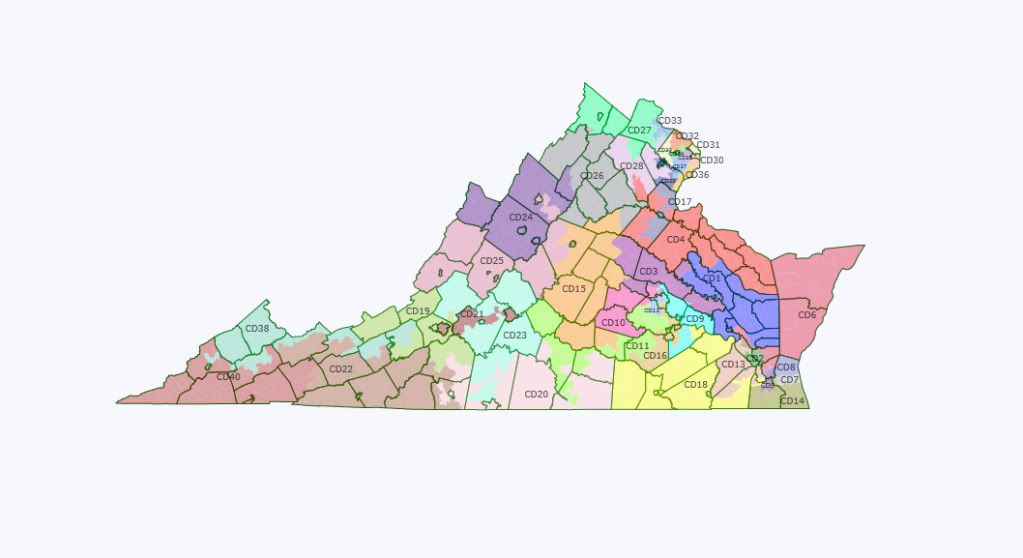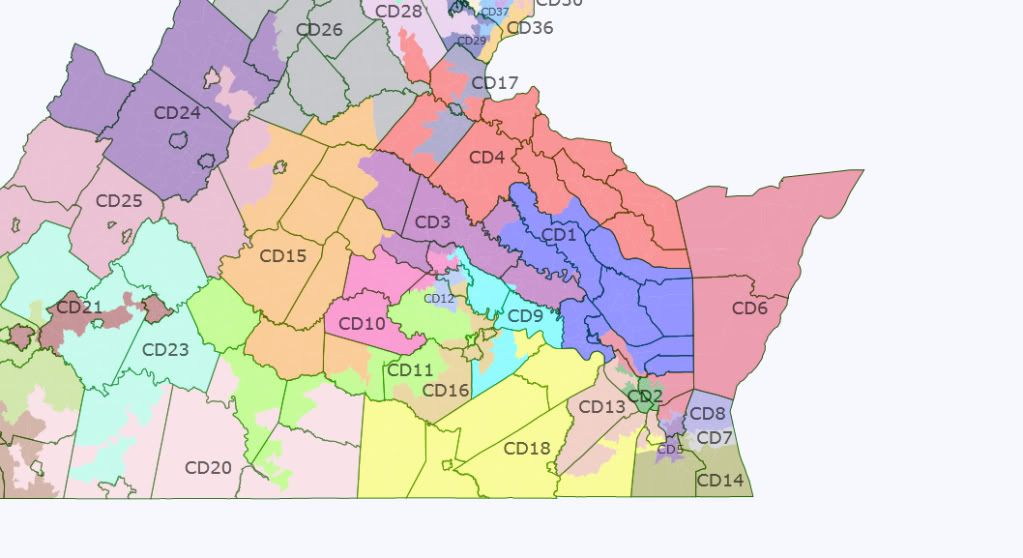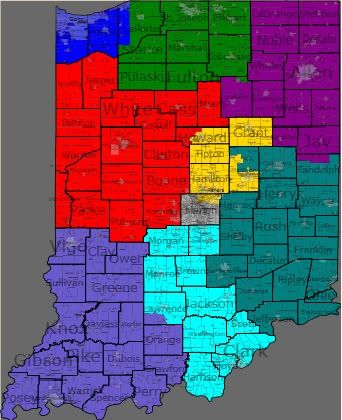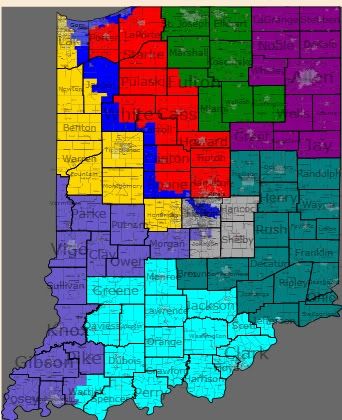Cross posted on my blog http://frogandturtle.blogspot…. which you should visit for more election analysis and redistricting maps.
Before November 2nd 2010, it appeared that Democrats would control the redistricting process because most polls suggested Jerry Brown (D) would become Governor. Brown did win and the Democrats retained their majorities in the state legislature. They, however, lost control of the redistricting process. The voters passed Proposition 20 which transferred the redistricting power from the state legislature to a 14 member commission compromised of 5 Democrats, 5 Republicans and 4 independents. The commission must draw districts according to communities of interest which are similar communities based on the residents’ ethnicities, location and income. Also, at least three members of each party must approve the map before it takes effect. Even if Democrats do not control redistricting the way they used to, they will certainly propose some maps to the committee that will protect Democratic incumbents and eliminate a few Republicans who are in gerrymandered districts. Although the Democrats crafted the 2002 map as a bipartisan plan, the lines resemble a Republican gerrymander. For example, San Bernardino and Riverside County both cast narrow majorities for Obama and have about 5 districts between them. A Democrat only holds one of those districts. The Democrat is Joe Baca (D) but his district does not even touch Riverside County. So Riverside County which voted for Obama and has enough people for nearly three districts does not even have a Democratic representative. Also, Orange County voted for McCain by three points and has around 3 million people, enough population for almost five districts. How many Democratic districts cover at least part of Orange County? The answer is only one: the 47th district represented by Loretta Sanchez (D) which covers Santa Ana and Anaheim. Although Democrats worry that the independent commission will carve up districts leaving Democratic incumbents with no familiar territory, Democrats should not be too worried. The commission likely will weaken many Republicans too.
This leads to why I am drawing this map and it is because I am predicting what the Democrats will propose to the commission. Although the commission makes the final decision, both parties will draw up proposals suggesting what the commission should do. For the Democrats, their proposal needs to protect their incumbents, create more opportunities in the Inland Empire and Central Valley while not drawing convoluted lines. Also, my proposal respects the VRA which requires a certain number of minority majority districts in order to ensure minorities are not underrepresented in the House. For example, I made the 15th and 32nd districts with Asian representatives more Asian. I also created three new districts designed to elect Hispanics because California’s Hispanic population is growing rapidly and will need representation. Also, California’s Hispanic population is 36% and there are only 8 Hispanic representatives in 53 congressional districts. The problem is that Hispanic turnout rates are low so districts with a Hispanic percentage of 51% will not have enough Hispanic voters to elect a Hispanic representative. If the district is Democratic but has Republican white voters though, there can be enough Hispanics in the Democratic primary to elect a Hispanic candidate. Some of my districts have low Hispanic populations but the population numbers are from 10 years ago so the Hispanic population should be larger. I also created 29 Safe Democratic seats, 5 Likely Democratic seats, 3 lean Democratic seats, 2 Toss Up seats, 2 Lean Republican seats, 2 Likely Republican seats (these could be competitive in a few years if demographic trends continue) and 10 Safe Republican seats. Safe represents a likely 20%+ win for the listed party, likely represents a likely 10%-19% win, lean represents a likely 5%-9% win and tossup represents a likely 0%-4% win. I wanted to create more seats for the Democrats but I did not want convoluted lines because the commission will reject those. Anyway, here are some helpful links and the maps:
Current maps of California’s congressional districts: http://www.nationalatlas.gov/p…
A few notes: if you want a better picture of the maps, click on them. Also, the demographics are from the 2000 census (2010 data is not available yet.) Old Demographics means the demographics of the old districts. “Change” represents how the partisan makeup of the district is compared to the old lines.

Northern California
California’s 1st Congressional District Mike Thompson (D)
Obama 190,394 64%, McCain 101,225 34%
Change: McCain +4
Demographics: 19% Hispanic, 69% White
Old Demographics: 17% Hispanic, 71% White
Communities of Interest: Eureka, Clear Lake, Napa
Status: Safe Democratic
Mike Thompson’s district becomes a few points more Republican with the loss of some Sonoma County towns and the addition of Republican Colusa and Glenn Counties. Those changes are not significant population wise and the Democratic counties of Yolo, Napa, Sonoma, Mendocino and Humboldt keep this district safe for Thompson.
California’s 2nd Congressional District Wally Herger (R)
Obama 123,563 42%, McCain 164,567 56%
Change: McCain +3
Demographics: 12% Hispanic, 78% White
Old Demographics: 14% Hispanic, 76% White
Communities of Interest: Redding, Chico, Yuba City
Status: Safe Republican
The district undergoes some geographical changes but the politics and the demographics of the district do not change much. The district loses Trinity, Colusa and Glenn Counties to the 1st but picks up Modoc, Lassen, Plumas and Sierra Counties to the east. Those counties make the district a bit more Republican but it was already safe for its representative who called a right wing terrorist a “Great American.” It also remains compact.

Sacramento Area
California’s 3rd Congressional District Dan Lungren (R)
Obama 144,028 51%, McCain 135,025 47%
Change: Obama +4
Demographics: 6% African American, 7% Asian, 11% Hispanic, 71% White
Old Demographics: 4% African American, 6% Asian, 10% Hispanic, 74% White
Communities of Interest: Citrus Heights, Folsom
Status: Toss Up
In 2008 and 2010, Democrats believed they had the candidate to beat Lungren but he held onto his seat. He won by seven points in 2010 against Ami Bera (D), a strong candidate in a strong Republican year. 2012 should be a neutral year at best for Republicans so if Bera runs again, he would have a strong chance to win. The district is more Democratic now because the district is entirely in Sacramento. It used to contain some Republican leaning rural counties but by losing those, the district becomes more Democratic.
California’s 4th Congressional District Tom McClintock (R)
Obama 152,125 45%, McCain 181,443 53%
Change: Obama +2
Demographics: 10% Hispanic, 82% White
Old Demographics: 9% Hispanic, 83% White
Communities of Interest: Roseville, Auburn, Nevada City
Status: Safe Republican
The district appears to undergo major changes by losing some northern rural counties but it actually keeps most of its residents. It becomes more of a Sacramento suburban district than a northern rural district though. It picks up rural parts of Yuba County and retains suburban Placer and El Dorado Counties while losing heavily Republican counties in northeast California. McClintock had a tough race here in 2008 and although the district becomes two points more Democratic, McClintock should be safe.
California’s 5th Congressional District Doris Matsui (D)
Obama 170,519 68%, McCain 75,712 30%
Change: McCain +4
Demographics: 13% African American, 16% Asian, 20% Hispanic, 45% White
Old Demographics: 14% African American, 15% Asian, 21% Hispanic, 43% White
Communities of Interest: Sacramento, Elk Grove
Status: Safe Democratic
Matsui’s district remains similar to its current configuration. It retains heavily minority and Democratic parts of Sacramento County. The only significant difference is that I extended her district up to the northern Sacramento County border to pick up some Republican areas to weaken the 3rd. Matsui’s district is completely safe for her and she is too popular for a successful primary challenge.

Bay Area
California’s 6th Congressional District Lynn Woolsey (D)
Obama 272,880 76%, McCain 81,299 23%
Change: McCain +1
Demographics: 15% Hispanic, 76% White
Old Demographics: 15% Hispanic, 76% White
Communities of Interest: Novato, San Rafael, Santa Rosa
Status: Safe Democratic
Besides losing the Mendocino County border and picking up the Sonoma Valley, the 6th district does not change much. It remains very white and heavily Democratic.
California’s 7th Congressional district George Miller (D)
Obama 213,820 64%, McCain 112,657 34%
Change: McCain +15
Demographics: 11% Asian, 12% Hispanic, 70% White
Old Demographics: 17% African American, 13% Asian, 21% Hispanic, 43% White
Communities of Interest: Pinole, Martinez, Danville
Status: Safe Democratic
Miller’s district becomes less Democratic by losing all of its territory except for Pinole, Concord and Martinez (his home.) I had to move Richmond out of his district to boost the African American population of the 9th district. I doubt Miller will like running under these new lines that now include Lafayette, Walnut Creek and Danville. Even though this is the Democrats’ proposal, they will have to make the lines compact for the commission to even consider the proposal. Anyway, this district is too Democratic for a Republican to win because Obama won 64% here which is higher than his statewide average of 61%. Also, no other representative lives in this district so Miller should not face a primary challenge.

San Francisco/Oakland
California’s 8th Congressional District Nancy Pelosi (D)
Obama 283,378 85%, McCain 41,932 13%
Change: McCain +1
Demographics: 8% African American, 28% Asian, 15% Hispanic, 44% White
Old Demographics: 9% African American, 29% Asian, 16% Hispanic, 43% White
Communities of Interest: San Francisco
Status: Safe Democratic
Pelosi’s district picks up a few precincts in the Sunset District but besides that, her district does not change at all.
California’s 9th District Barbara Lee (D)
Obama 275,448 90%, McCain 23,750 8%
Change: Obama +4
Demographics: 28% African American, 16% Asian, 20% Hispanic, 32% White
Old Demographics: 26% African American, 15% Asian, 19% Hispanic, 35% White
Communities of Interest: Richmond, Berkeley, Oakland
Status: Safe Democratic
Lee’s district does change a bit as it loses a few Hispanic neighborhoods in South Oakland. Her district’s population growth was minimal so it needed to pick up people. It moved north into Contra Costa County to pick up Richmond with a large African American population. Although Lee should be reelected, she will want a high African American population. Her district will get 2 points more African American and it will be even more Democratic.
California’s 10th Congressional District John Garamendi (D)
Obama 170,310 62%, McCain 99,929 36%
Change: McCain +6
Demographics: 12% African American, 11% Asian, 20% Hispanic, 52% White
Old Demographics: 6% African American, 9% Asian, 15% Hispanic, 65% White
Communities of Interest: Vallejo, Fairfield, Pittsburg
Status: Safe Democratic
Garamendi’s district picks up Vallejo in Solano County. It loses Livermore which voted for Bush in 2004, and the 10th district loses the Walnut Creek area. To compensate for the loss of those areas, the 10th district picks up all of Solano County including heavily Democratic Vallejo. The 10th district picks up heavily Democratic Pittsburg too in Contra Costa County. The 10th district also picks up more Central Valley territory because the population growth in the Bay Area is slower than the rest of the state and I needed to push the districts further east to make sure the districts had equal populations. Picking up Lodi to protect McNerney in the 11th district who won by only one point in 2010 does make the 10th district a couple points more Republican. A 62% Obama percentage is high enough to keep Garamendi safe though. Also, Obama did well in the Walnut Creek area formerly in the 10th district but many of the voters there can swing to Republicans. The Democrats in Vallejo and Pittsburg which I moved into the 10th district usually stick with the Democratic ticket though.
California’s 11th District Jerry McNerney (D)
Obama 117,796 56% McCain 90,747 43%
Change: Obama +3
Demographics: 7% African American, 12% Asian, 30% Hispanic, 47% White
Old Demographics: 3% African American, 9% Asian, 20% Hispanic, 64% White
Communities of Interest: Tracy, Stockton, Modesto
Status: Lean Democratic
At a first glance, it appears that McNerney’s district becomes more Republican because it loses all of its territory in Democratic Contra Costa, Alameda and Santa Clara Counties. McNerney’s district becomes three points more Democratic though with the addition of Democratic parts of Stockton, the removal of Lodi and the addition of Democratic parts of Modesto. I did not want to county split here but for population purposes, I had to do so. McNerney should still face challenges but if he could survive in a more Republican district in a very Republican year, he should win in this new district.
California’s 12th District Jackie Speier (D)
Obama 216,757 74%, McCain 70,939 24%
Change: McCain +0
Demographics: 28% Asian, 19% Hispanic, 46% White
Old Demographics: 29% Asian, 16% Hispanic, 48% White
Communities of Interest: South San Francisco, Redwood City, Half Moon Bay
Status: Safe Democratic
Speier’s district shifts a bit south. She loses a few neighborhoods in SF but picks up some Hispanic neighborhoods in Redwood City. She also picks up Half Moon Bay and all of rural San Mateo County. These changes do not significantly alter her Democratic district.
California’s 13th District Pete Stark (D)
Obama 196,889 73%, McCain 68,594 25%
Change: McCain +2
Demographics: 9% African American, 22% Asian, 22% Hispanic, 42% White
Old Demographics: 6% African American, 28% Asian, 21% Hispanic, 38% White
Communities of Interest: San Leandro, Fremont, Pleasanton
Status: Safe Democratic
Stark’s district gets a few points more Republican with the addition of Dublin and Pleasanton. I did not want to connect Stark’s district with those areas but I had to add them for population purposes. Anyway, the district still stays heavily Democratic and safe for Stark.

San Jose
California’s 14th District Anna Eshoo (D)
Obama 224,972 70% McCain 89,228 28%
Change: McCain +6
Demographics: 15% Asian, 14% Hispanic, 63% White
Old Demographics: 16% Asian, 17% Hispanic, 59% White
Communities of Interest: Mountain View, Saratoga, San Jose
Status: Safe Democratic
Eshoo’s district becomes a few points more Republican by losing northern Santa Cruz County and picking up western San Jose. Yes, I understand that Tom Campbell (R) held a district in the 1990’s similar to this one. The 14th district has trended Democratic rapidly though in the last ten years and Obama won 70% of the vote here. Eshoo should have absolutely no worries, even if Campbell decided to run.
California’s 15th District Mike Honda (D)
Obama 172,003 70% McCain 69,337 28%
Change: Obama +4
Demographics: 39% Asian, 15% Hispanic, 40% White
Old Demographics: 29% Asian, 17% Hispanic, 47% White
Communities of Interest: Fremont, Cupertino, San Jose
Status: Safe Democratic
This district becomes more Asian by losing white neighborhoods in San Jose while picking up Asian neighborhoods in Fremont and Sunnyvale. It also picks up a few Asian neighborhoods south of Milpitas. These changes bring the Asian population to 39%. The commission has 5 Asians so I expect they will create some districts that will elect Asians such as this one. Honda is Asian but the Asian population in this district ensures that his successor will be too. Although the district is plurality white, these are 2000 population numbers and the district should have a 43%-44% Asian population now, making it plurality Asian.
California’s 16th Congressional District Zoe Lofgren (D)
Obama 152,658 70%, McCain 62,467 29%
Change: McCain +0
Demographics: 23% Asian, 40% Hispanic, 30% White
Old Demographics: 23% Asian, 38% Hispanic, 31% White
Communities of Interest: San Jose, Gilroy, Morgan Hill
Status: Safe Democratic
Lofgren’s district does not become less Democratic or Republican but an issue arises. Her district gets a few points more Hispanic and with her district’s growing Hispanic population, she may face a primary challenge from a Hispanic. Lofgren should win though because she is familiar with most of the 16th district’s voters and the Hispanic population is still not high enough to unseat her. If she retires in a few years, Hispanics will have a big chance to elect a representative here. Anyway, she gets new territory in Hispanic Gilroy and Morgan Hill. Her district keeps communities of interest though by staying within the county boundaries.

Central California
California’s 17th District Sam Farr (D)
Obama 194,877 71%, McCain 75,094 27%
Change: McCain +2
Demographics: 5% Asian, 35% Hispanic, 54% White
Old Demographics: 5% Asian, 43% Hispanic, 46% White
Communities of Interest: Santa Cruz, Monterey, Paso Robles
Status: Safe Democratic
Farr’s district becomes a few points more Republican but remains very safe. It is still a compact district containing all of Monterey and Santa Cruz Counties while taking a small slice of San Luis Obispo County. The district loses all of agricultural San Benito County to the agricultural 18th district. The 17th picks up Republican leaning Paso Robles because it is in the Salinas Valley which is a community of interest in Monterey County. This also keeps Paso Robles out of the 23rd district.
California’s 18th District Dennis Cardoza (D)
Obama 101,440 55%, McCain 80,417 43%
Change: McCain +8
Demographics: 5% Asian, 45% Hispanic, 43% White
Old Demographics: 6% African American, 9% Asian, 42% Hispanic, 39% White
Communities of Interest: Hollister, Modesto, Merced
Status: Likely Democratic
Cardoza’s district becomes more Republican because the commission will want it to have compact lines. Thus, it will lose the finger into heavily Democratic Stockton. To compensate for the loss, the 18th district will go over the Diablo Range to pick up San Benito County which is mostly agricultural like the rest of the district and leans Democratic. The district splits Madera County with the 19th which breaks county lines but western Madera is very similar to the rest of the district so it is a community of interest. As for Cardoza himself, his district is more Republican because he loses his stronghold of Stockton. The district is growing Democratic though, he won strongly in 2010, a very Republican year and the current Hispanic population should be close to 50% instead of 45%. He may face a tough challenge in a Republican year but he seems safe enough.
California’s 19th District Jeff Denham (R)
Obama 100,428 42%, McCain 136,148 56%
Change: McCain +8
Demographics: 28% Hispanic, 63% White
Old Demographics: 28% Hispanic, 59% White
Communities of Interest: Turlock, Mammoth Lakes, Barstow
Status: Safe Republican
The Sierras and the Mojave Desert used to be diced up between the Los Angeles centered 25th district and the formerly Central Valley centered 19th district so they were not united in one district. They are now part of the new 19th which is probably the most rural district in California now. The 19th loses all of Fresno and the parts of the Central Valley it has are mostly rural and white. Barstow may be far from the northern part of the district but these areas have similar residents. As for Denham, his district was already safe so he should be fine.

Fresno Area
California’s 20th District Jim Costa (D)
Obama 89,084 59%, McCain 60,278 40%
Change: McCain +2
Demographics: 7% African American, 9% Asian, 55% Hispanic, 26% White
Old Demographics: 7% African American, 6% Asian, 63% Hispanic, 21% White
Communities of Interest: Fresno, Delano
Status: Likely Democratic
Costa faced a tough reelection bid and I would have strengthened his position but I wanted a district that the commission would approve due to compactness. His district gets a couple of points more Republican but he loses part of heavily Republican Kings County which has more in common with Tulare County which is partly in the 21st district. In his close 2010 reelection, he lost Kings County by more than 20 points. Costa gains more of his base in Fresno County. His district has a minority population of 74% as of 2000. It should be larger now. Nonetheless, since he won in 2010, he should be able to win in any year.
California’s 21st District Devin Nunes (R)
Obama 95,433 41%, McCain 132,702 57%
Change: McCain +2
Demographics: 5% Asian, 34% Hispanic, 54% White
Old Demographics: 5% Asian, 43% Hispanic, 46% White
Communities of Interest: Clovis, Visalia, Hanford
Status: Safe Republican
With the addition of half of Kings County, the 21st district becomes more Republican. While it loses some Republican parts of Tulare County, it also loses some Democratic parts of Fresno County. Although the district looks less compact than its original form, it still contains similar communities.
California’s 22nd District Kevin McCarthy (R)
Obama 81,294 40%, McCain 120,919 59%
Change: Obama +2
Demographics: 6% African American, 35% Hispanic, 53% White
Old Demographics: 6% African American, 21% Hispanic, 67% White
Communities of Interest: Shafter, Bakersfield, California City
Status: Safe Republican
The district loses portions of Los Angeles and San Luis Obispo Counties. It is now completely in Kern County and it picks up some Democratic neighborhoods in Bakersfield. This makes the 22nd more Democratic but it is still strongly Republican and more compact.
California’s 23rd District Lois Capps (D)
Obama 183,937 58%, McCain 127,332 40%
Change: McCain +16
Demographics: 27% Hispanic, 64% White
Old Demographics: 5% Asian, 41% Hispanic, 48% White
Communities of Interest: San Luis Obispo, Santa Barbara, Ventura
Status: Likely Democratic
Santa Barbara, a liberal university town with an economy based largely on tourism is not too similar to northern Santa Barbara County which is conservative and has an economy based on the Vanderburg Air Force Base and agriculture. Northern Santa Barbara County has tried to split from Santa Barbara County for those reasons. The 23rd district will unite them though because compactness is important. The 23rd also picks up all of San Luis Obispo County. The district loses heavily Democratic Oxnard which brings the McCain percentage up to 40%. In the 1990s, the district was competitive with similar lines but this area has trended Democratic since then so I expect Capps will retain her seat.
California’s 24th District Elton Gallegly (R)
Obama 158,267 55%, McCain 126,731 44%
Change: Obama +8
Demographics: 6% Asian, 34% Hispanic, 55% White
Old Demographics: 4% Asian, 22% Hispanic, 69% White
Communities of Interest: Oxnard, Moorpark, Simi Valley
Status: Tossup
This district loses the conservative parts of Santa Barbara County and picks up heavily Democratic Oxnard instead. This increases the Obama percentage in the district to 55%. Gallegly is an entrenched incumbent but he is not familiar with the voters in Oxnard. Gallegly could win by winning big margins in Simi Valley and Thousand Oaks. Gallegly keeps hinting he wants to retire so these new lines may convince him to do so. If he leaves, the seats will be hotly contested but I expect the Democrat to win by a few points.

West LA
California’s 25th District Buck McKeon (R)
Obama 139,488 50% McCain 132,660 48%
Change: McCain +0
Demographics: 9% African American, 5% Asian, 27% Hispanic, 55% White
Old Demographics: 8% African American, 4% Asian, 27% Hispanic, 57% White
Communities of Interest: Santa Clarita, Palmdale, Victorville
Status: Likely Republican
This district shrinks as it loses rural areas in the desert and eastern Sierras. It still resembles a tossup because Obama barely won it but this district is strongly Republican. Kerry won only 40% here and McKeon is highly popular. When he retires, a strong Democrat against a weak Republican can win here but although this area is trending Democratic, it is still Republican at a local level.
California’s 26th District Darrell Issa (R) Grey
Obama 143,487 49%, McCain 142,232 49%
Change: Obama +8 (the old 49th District.)
Demographics: 5% Asian, 26% Hispanic, 62% White
Old Demographics: 5% African American, 4% Asian, 30% Hispanic, 57% White
Communities of Interest: San Clemente, Oceanside, Carlsbad
Status: Lean Republican
Although Issa represents the 49th district currently, this district has most of the old 49th district including his home so I expect him to run here. The district has become more Democratic with the removal of conservative inland areas and the addition of some coastal towns such as Carlsbad which lean Democratic. He does pick up conservative San Clemente in Orange County though. Even though Obama won this district, Issa should have an advantage because he contains most of his old territory. A Democratic candidate such as Nick Leibham could run a strong race here though.

LA Area Zoom out
California’s 27th District Adam Schiff (D) (formerly represented the 29th)
Obama 185,229 68%, McCain 79,728 29%
Change: Obama +1
Demographics: 6% African American, 14% Asian, 32% Hispanic, 43% White
Old Demographics: 6% African American, 24% Asian, 26% Hispanic, 39% White
Communities of Interest: Burbank, Glendale, Pasadena
Status: Safe Democratic
Schiff’s district picks up some Hispanics in a few LA neighborhoods and loses a few Asian areas in the eastern part of the district to the 32nd. The district does not undergo major changes overall. Schiff should have no difficulties retaining his seat.
California’s 28th District Vacant
Obama 123,900 72%, McCain 43,547 25%
Change: McCain +8
Demographics: 5% African American, 7% Asian, 64% Hispanic, 21% White
Old Demographics: 4% African American, 6% Asian, 56% Hispanic, 31% White
Communities of Interest: San Fernando, Los Angeles
Status: Safe Democratic
No matter what the Democrats or Republicans propose, the commission will probably create a strong Hispanic majority district in the San Fernando Valley due to its high Hispanic population and the lack of a Hispanic representative. This district formerly belonged to Howard Berman (D) but he will probably run in the new 30th District or retire. Regardless, a 64% Hispanic population should be enough for a Hispanic to win. A possible candidate would be rising star Alex Padilla (D).
California’s 29th District Henry Waxman (D) (formerly represented the 30th)
Obama 271,019 76%, McCain 78,109 22%
Change: Obama +12
Demographics: 10% Asian, 13% Hispanic, 69% White
Old Demographics: 9% Asian, 8% Hispanic, 76% White
Communities of Interest: Malibu, Beverly Hills, Los Angeles
Status: Safe Democratic
This district was formerly the 30th District. It looks different though because it loses neighborhoods in the San Fernando Valley and towns such as Agoura Hills and Calabasas. The district picks up some of Venice Beach to compensate for the population loss. This helps make the district more Democratic even though this district full of Hollywood liberals was safe for Waxman already.
California’s 30th District Howard Berman (D) vs. Brad Sherman (D) (formerly the 27th)
Obama 193,870 65%, McCain 99,181 33%
Change: McCain +2
Demographics: 10% Asian, 21% Hispanic, 61% White
Old Demographics: 5% African American, 11% Asian, 37% Hispanic, 44% White
Communities of Interest: Agoura Hills, Chatsworth, Northridge
Status: Safe Democratic
This district changes as it picks up the Agoura Hills and Northridge areas. Although this district is too Democratic for a Republican, there might be a big primary fight here. I am not sure if the Democratic party will like combining the two incumbents but the commission will do it in order to create a Hispanic majority district in the San Fernando Valley. This district combines most of the white parts of the San Fernando Valley. Although this district contains more of Sherman’s territory, Berman is more entrenched and he has the backing of Waxman. His backing may translate into votes in the parts of Waxman’s old district such as Agoura Hills and Calabasas if Waxman campaigns strongly for Berman. Anyway, this will be an interesting race or Sherman may decide not to run here but run in the nearby 24th instead if Gallegly retires.
California’s 31st District Xavier Beccara (D)
Obama 111,611 81%, McCain 22,567 16%
Change: Obama +2
Demographics: 7% African American, 17% Asian, 64% Hispanic, 9% White
Old Demographics: 4% African American, 14% Asian, 70% Hispanic, 10% White
Communities of Interest: Downtown Los Angeles, Clement Junction, Silver Lake
Status: Safe Democratic
Beccara’s district becomes more compact as it picks up areas such as Boyle Heights from the 34th District. It loses a few Hispanics but still remains heavily Hispanic and Democratic.

Los Angeles Zoom in
California’s 32nd District Judy Chu (D)
Obama 134,143 59% McCain 86,631 38%
Change: McCain +17
Demographics: 31% Asian, 38% Hispanic, 25% White
Old Demographics: 18% Asian, 62% Hispanic, 15% White
Communities of Interest: Monterey Park, El Monte, Glendora
Status: Safe Democratic
The commission will probably create a district where an Asian candidate can win in this part of LA County. The district could be extended into Asian neighborhoods in Diamond Bar but I doubt they will do that because it will create convoluted lines if they want to connect Asian areas in Monterey Park and Diamond Bar. The 32nd district loses Hispanic Baldwin Park but picks up Asian areas near Arcadia. Although Asians are not the plurality in the district, they have higher voter turnout rates than Hispanics so Chu should survive a primary challenge from a Hispanic candidate. Chu’s current district is 62% Hispanic and 18% Asian so the possibility of a strong Hispanic candidate challenging her in the primary looms. The district becomes more Republican because the new Asian areas such as San Marino and Arcadia are not heavily Democratic. Obama’s 21 point win here should be high enough to protect Chu and she should perform higher than Obama among Asians too.
California’s 33rd District Karen Bass (D) Purple
Obama 208,574 90% McCain 20,884 9%
Change: Obama +6
Demographics: 39% African American, 6% Asian, 44% Hispanic, 9% White
Old Demographics: 30% African American, 12% Asian, 35% Hispanic, 20% White
Communities of Interest: Los Angeles, Culver City, Inglewood
Status: Safe Democratic
With the inclusion of Inglewood, this becomes the most Democratic district in California. The district becomes more Democatic. On this new map, it is the most Democratic district in California. Also, I had to eliminate one African American district in LA because it will be difficult for all three African Americans to hold their districts as the Hispanic population grows. Bass’s district’s African American population rises from 30% to 39%. While Hispanics are still a plurality here, African Americans make up the majority of Democratic primary voters so Bass should be safe.
California’s 34th District Lucille Roybal Allard (D) Green
Obama 129,907 73%, McCain 44,871 25%
Change: McCain +4
Demographics: 5% Asian, 78% Hispanic, 12% White
Old Demographics: 6% Asian, 77% Hispanic, 11% White
Communities of Interest: East Los Angeles, Downey, Norwalk
Status: Safe Democratic
Yes, I understand this district may be too narrow and too long so the commission may not think it is compact. A district like this is necessary though because if it were more compact around the East Los Angeles area, the Hispanic population would be considered too high and it would be considered packing under the VRA. Many of the Hispanic areas there are around 90% Hispanic. Other Hispanic majority districts would not have enough Hispanics to elect a Hispanic representative if they cannot pick up heavily Hispanic neighborhoods such as East Los Angeles, Pico Rivera and Lynwood. Anyway, Allard’s district is still 78% Hispanic even while picking up less Hispanic Whittier and Norwalk which makes the district a few points more Republican but still safe for Allard.
California’s 35th District Maxine Waters (D)
Obama 174,206 84%, McCain 29,312 14%
Change: McCain +0
Demographics: 35% African American, 10% Asian, 46% Hispanic, 7% White
Old Demographics: 34% African American, 6% Asian, 47% Hispanic, 10% White
Communities of Interest: Gardena, Compton, Carson
Status: Safe Democratic
The 35th District is now a combination of the current 35th and 37th districts but much of the 37th District is in the new 46th District so Waters has a bit more territory here. Although her district loses her base of Inglewood and picks up Compton and Carson from the 37th District, Waters should win.
California’s 36th District Vacant
Obama 183,287 60%, McCain 115,882 38%
Change: McCain +8
Demographics: 14% Asian, 29% Hispanic, 49% White
Old Demographics: 13% Asian, 30% Hispanic, 48% White
Communities of Interest: Manhattan Beach, Torrance, Rancho Palos Verdes
Status: Safe Democratic
The district becomes more Republican as it loses most of Venice Beach and picks up Republican leaning Rancho Palos Verdes. This district had similar territory in the 1990s and was very competitive. The territory has trended Democratic very quickly with Kerry performing better than Gore here while Gore performed better than Kerry statewide. Obama’s 60% of the vote here is very close to his statewide average of 61%. The current congresswoman Jane Harman (D) will resign soon. The Democrats though have strong candidates running to including former city councilwoman Janice Hahn (D) and popular Secretary of State Debra Bowen (D). They should keep this district in the Democratic column.
California’s 37th District David Dreier (R) (formerly the 26th District)
Obama 128,094 56%, McCain 95,077 42%
Change: Obama +10
Demographics: 7% African American, 9% Asian, 44% Hispanic, 37% White
Old Demographics: 4% African American, 15% Asian, 24% Hispanic, 52% White
Communities of Interest: Covina, Pomona, Chino Hills
Status: Likely Democratic
The 37th straddles the border between Los Angeles and San Bernardino Counties. As for the party strength in this district, Obama may have won with 56% of the vote here but if the Republican candidate is extremely popular and can make inroads with Hispanics, he or she could win. David Dreier (R)’s district was eliminated on this map. He could run here because it contains part of his old district with Upland but he is not familiar with the mostly Democratic Covina or Pomona voters so a Democrat could win here with large margins from those two cities. As for Hispanic representation, the district is probably close to 50% Hispanic now. They would not make up the majority of the votes but there may be enough Hispanics to elect a Hispanic in the Democratic primary because many of the white voters in this district are Republican.
California’s 38th District Grace Napolitano (D)
Obama 142,359 67%, McCain 67,249 31%
Change: McCain +8
Demographics: 21% Asian, 60% Hispanic, 14% White
Old Demographics: 10% Asian, 71% Hispanic, 14% White
Communities of Interest: Pico Rivera, Baldwin Park, Diamond Bar
Status: Safe Democratic
This district becomes more Republican by losing Norwalk and picking up Diamond Bar. Napolitano lives in Norwalk but she should run here since it contains most of her old district. Also, the district loses Hispanics but the 60% Hispanic population should protect Napolitano.
California’s 39th District Linda Sanchez (D)
Obama 126,006 72%, McCain 46,251 26%
Change: Obama +12
Demographics: 9% African American, 9% Asian, 67% Hispanic, 14% White
Old Demographics: 6% African American, 10% Asian, 61% Hispanic, 21% White
Communities of Interest: Huntington Park., Lynwood, Lakewood
Status: Safe Democratic
The district becomes more Democratic and Hispanic with the loss of swing areas such as La Mirada and the addition of heavily Hispanic Huntington Park. Sanchez should have no problems here.

Orange/Riverside Counties
California’s 40th District Ed Royce (R)
Obama 125,615 48%, McCain 131,448 50%
Change: Obama +2
Demographics: 14% Asian, 32% Hispanic, 48% White
Old Demographics: 16% Asian, 30% Hispanic, 49% White
Communities of Interest: La Mirada, Fullerton, Orange
Status: Likely Republican
Royce’s district keeps most of its old territory but expands a bit. It picks up the swing area La Mirada in Los Angeles County as well as Whittier. It loses marginal Los Alamitos. These changes make the district a bit more Democratic. Royce is popular here though so he should win. If Royce retires at the end of the decade though, a Democrat could make this competitive.

San Bernardino Area
California’s 41st District Jerry Lewis (R)
Obama 114,430 43%, McCain 145,829 55%
Change: McCain +2
Demographics: 5% African American, 23% Hispanic, 65% White
Old Demographics: 5% African American, 23% Hispanic, 64% White
Communities of Interest: Rancho Cucamonga, Redlands, Banning
Status: Safe Republican
The district grew so it will shed some territory. It lost most of rural San Bernardino County including Barstow and Needles. It also loses Republican leaning Hemet and San Jacinto. It does pick up Republican leaning Rancho Cucamonga though. Rancho Cucamonga is not next to the bulk of the district’s population which is east of San Bernardino and Riverside. Rancho Cucamonga can be considered a community of interest though because it has similar demographics and voting habits with the rest of the district. Also, connecting Rancho Cucamonga to the rest of the district does not create convoluted lines.
California’s 42nd District Gary Miller (R)
Obama 147,589 46%, McCain 170,780 53%
Change: Obama +1
Demographics: 15% Asian, 14% Hispanic, 66% White
Old Demographics: 16% Asian, 24% Hispanic, 54% White
Communities of Interest: Yorba Linda, Irvine, Lake Forest
Status: Safe Republican
Gary Miller’s home is now in the heavily Hispanic 38th district but I believe he will run here since this district contains much of his old territory. The district is now completely in Orange County and it picks up Democratic leaning Irvine. These changes do not change the political composition of the district much though. Miller should be safe.
California’s 43rd District Joe Baca (D)
Obama 106,880 64%, McCain 55,738 34%
Change: McCain +8
Demographics: 14% African American, 5% Asian, 50% Hispanic, 28% White
Old Demographics: 12% African American, 3% Asian, 58% Hispanic, 23% White
Communities of Interest: Fontana, Colton, San Bernardino
Status: Safe Democratic
The district becomes more Republican and less Hispanic by losing Democratic Ontario and picking up Republican leaning Highland. The district is 72% minority and the minority percentage should be higher now. The Hispanic population of the old district was 58% in 2000 but grew to 66% in 2010 so the Hispanic population of this district should currently be in the high 50’s. That should be enough to protect Baca.
California’s 44th District Vacant (R)
Obama 95,838 62% McCain 54,979 36%
Change: N/A
Demographics: 11% African American, 5% Asian, 48% Hispanic, 33% White
Old Demographics: N/A
Communities of Interest: Ontario, Riverside, Moreno Valley
Status: Likely Democratic
This is the new minority majority district in the Inland Empire which contains Hispanic neighborhoods in Ontario as well as Riverside and Moreno Valley. The district was not Hispanic majority in 2000 but should be in the low 50s now. Although Hispanics may not make up the majority of the voters, they should make up the majority of the Democratic primary voters because many of the whites in the 44th District vote Republican. Also, this district is too Democratic to elect a Republican so the Democrat who wins here should be safe.
California’s 45th District Ken Calvert (R) (formerly the 44th)
Obama 104,697 49% McCain 103,291 49%
Change: McCain +1
Demographics: 6% African American, 5% Asian, 33% Hispanic, 52% White
Old Demographics: 6% African American, 5% Asian, 35% Hispanic, 51% White
Communities of Interest: Corona, Riverside, San Jacinto
Status: Lean Republican
This district at first looks like a pure tossup when considering the vote totals but it leans Republican because Obama over performed in the Inland Empire. Democrats have a shot here though because Ken Calvert (R) is a weak incumbent and won in 2008 only because of margins in Orange County. His district loses Orange County while picking up Democratic Perris and marginal San Jacinto. Although the district gets a point more Republican, it is quickly trending Democratic. Also, Bill Hedrick (D) in 2008 received almost no support from national Democrats but lost by only 2 points against Calvert. If Hedrick runs in a good Democratic year and receives support from national Democrats, he should win.
California’s 46th District Dana Rohrabacher (R)
Obama 149,749 58% McCain 103,370 40%
Change: Obama +20
Demographics: 8% African American, 16% Asian, 30% Hispanic, 42% White
Old Demographics: 1% African American, 15% Asian, 17% Hispanic, 62% White
Communities of Interest: Long Beach, Seal Beach, Huntington Beach
Status: Lean Democratic
The district becomes more Democratic with the addition of Democratic areas in Long Beach. The removal of Costa Mesa and most of Huntington Beach helps too. Rohrabacher is popular but even he should not win in a 58% Obama district. Also, the new Democratic voters from Long Beach are not familiar with him so he will not be able to win by getting Democrats in Long Beach to ticket split. An issue with this district is that western Long Beach may not be considered a community of interest with the rest of the district. It should work because it is in the same city limits as eastern Long Beach which is currently in the 46th District and should be a community of interest with the Orange County part of the district. Also, the addition of most of Long Beach makes the district compact and it formerly had a thin line going to Rancho Palos Verdes.
California’s 47th District Loretta Sanchez (D)
Obama 85,661 59%, McCain 57,061 39%
Change: McCain +1
Demographics: 15% Asian, 62% Hispanic, 19% White
Old Demographics: 14% Asian, 65% Hispanic, 17% White
Communities of Interest: Anaheim, Santa Ana, Garden Grove
Status: Safe Democratic
Sanchez’s district does not change much because it is already a Hispanic majority district and it contains similar communities. She picks up more of Garden Grove which may not be the best idea because her 2010 challenger Van Tran (R) is popular there. She should be safe because she won by double digits in 2010, an extremely Republican year and if she were strong then, she is strong now.
California’s 48th District John Campbell (R)
Obama 150,612 46%, McCain 167,583 52%
Change: McCain +8
Demographics: 8% Asian, 16% Hispanic, 71% White
Old Demographics: 13% Asian, 15% Hispanic, 68% White
Communities of Interest: Huntington Beach, Newport Beach, Laguna Beach
Status: Safe Republican
Campbell’s district loses Irvine and becomes the coastal district. It picks up Huntington Beach and Costa Mesa. Although the district is narrow, it certainly picks up communities of interest by getting all the beach towns. The district becomes more Republican with the loss of Irvine but Campbell was pretty safe anyway. This district may be open to voting for a libertarian Democrat if they view Campbell as one of the big government Republicans but for now, this district remains Republican.
California’s 49th District Mary Bono (R) (formerly the 45th District)
Obama 116,668 44%, McCain 145,303 55%
Change: McCain +16
Demographics: 23% Hispanic, 68% White
Old Demographics: 6% African American, 38% Hispanic, 50% White
Communities of Interest: Lake Elsinore, Temecula, Palm Springs
Status: Safe Republican
Bono’s old district contained Moreno Valley and voted for Obama by 5 points. Her district is now more Republican with the removal of Moreno Valley and heavily Hispanic Coachella. Her district picks up Republican Murrieta and Temecula though. Although Palm Springs leans Democratic, Murrieta and Temecula more than cancel out the Democratic votes there.

San Diego Area
California’s 50th District Brian Bilbray (R)
Obama 201,068 59%, McCain 133,105 39%
Change: Obama +16
Demographics: 15% Asian, 11% Hispanic, 67% White
Old Demographics: 10% Asian, 19% Hispanic, 66% White
Communities of Interest: Del Mar, San Diego
Status: Lean Democratic
Bilbray has represented San Diego for a number of years and he is used to running in districts that lean Democratic. His old 50th District voted for Obama by a couple of points. He should lose in this district though because he picks up more of San Diego City including some white liberal areas from the 53rd. This increases the Obama percentage to 59% and that should be enough to beat him. This district also fits the guidelines for the commission by remaining compact and taking in similar neighborhoods. It is possible Susan Davis (D) from the 53rd will run here because her district’s white population may be too small for her and the 50th district contains part of her old district. She ran against Bilbray in 2000 and it will be an interesting rematch. She should win though.
California’s 51st District Bob Filner (D)
Obama 119,277 58%, McCain 82,165 40%
Change: McCain +9
Demographics: 6% Asian, 61% Hispanic, 26% White
Old Demographics: 9% African American, 12% Asian, 53% Hispanic, 21% White
Communities of Interest: Coachella, El Centro, Chula Vista
Status: Safe Democratic
Bob Filner is a popular representative but the commission will create a Hispanic majority district with parts of San Diego. He has handily beaten back primary challenges from Hispanics though in a 53% Hispanic district. He won with support from African Americans and Asians and he loses many of those voters to the 53rd district. He retains most of his old territory so he may survive. Nonetheless, his district becomes more Hispanic by picking up Coachella and Indio. I have also heard of proposals to connect Imperial County to an eastern San Diego County district. Those areas do not have much in common though and Hispanics need a district in the San Diego area. The district becomes more Republican too though by losing National City and some Democratic neighborhoods in San Diego but remains safe for Filner.
California’s 52nd District Duncan Hunter Jr. (R)
Obama 128,894 44%, McCain 160,825 55%
Change: McCain +3
Demographics: 5% Asian, 18% Hispanic, 69% White
Old Demographics: 5% Asian, 14% Hispanic, 73% White
Communities of Interest: Poway, San Diego, El Cajon
Status: Safe Republican
The district was already Republican but it becomes even more Republican. It loses most of San Diego City except the northeastern area and picks up Republican leaning Escondido. Hunter should have no problems here.
California’s 53rd District Susan Davis (D)
Obama 116,327 70%, McCain 46,533 28%
Change: Obama +4
Demographics: 14% African American, 14% Asian, 42% Hispanic, 26% White
Old Demographics: 7% African American, 8% Asian, 29% Hispanic, 51% White
Communities of Interest: National City, San Diego
Status: Safe Democratic
Davis’s district gets less white as it loses more northern parts of San Diego and picks up National City. These changes make the district more Democratic but less safe for Davis. She faces the possibility of a primary challenge from a minority candidate. She should survive because many of the voters in the new 53rd are from her old district and whites probably outnumber Hispanics in the Democratic primary. Also, Davis should get support from African Americans and Asians. Filner may give her a primary challenge here though.

Loading ...
